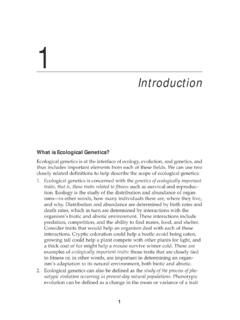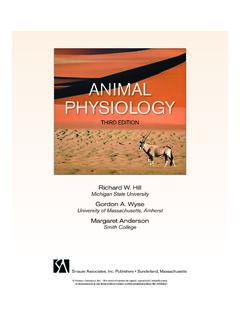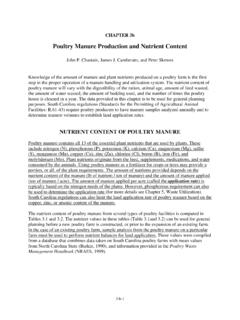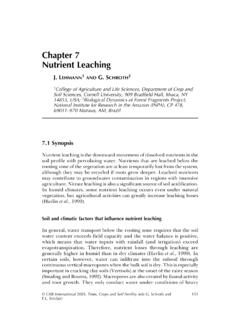Transcription of Plant Physiology, Fifth Edition - Sinauer Associates
1 Lincoln Taiz Professor EmeritusUniversity of California, Santa CruzEduardo ZeigerProfessor EmeritusUniversity of California, Los AngelesFifth EditionifthditiFifth Editi Sinauer Associates Inc., Publishers Sunderland, Massachusetts III5/19/10 4:08:58 PM 2012 Sinauer Associates , Inc. This material cannot be copied, reproduced, manufacturedor disseminated in any form without express written permission from the publisher. Sinauer Associates , Inc. This material cannot be copied, reproduced, manufactured or disseminated in any form without express written permission from the Life: Unifying Principles 2 Overview of Plant Structure 2 Plant cells are surrounded by rigid cell walls 2 New cells are produced by dividingtissues called meristems 2 Three major tissue systems make up the Plant body 4 Plant Cell Organelles 4 Biological membranes are phospholipid bilayers that contain proteins 4 The Endomembrane System 8 The nucleus contains the majority of thegenetic material 8 Gene expression involves both transcriptionand translation 10 The endoplasmic reticulum is a network of internal membranes 10 Secretion of proteins from cells begins with the rough ER (RER)
2 13 Glycoproteins and polysaccharides destined for secretion are processed in the Golgi apparatus 14 The plasma membrane has specialized regions involved in membrane recycling 16 Vacuoles have diverse functions in Plant cells 16 Independently Dividing Organelles Derived from the Endomembrane System 17 Oil bodies are lipid-storing organelles 17 Microbodies play specialized metabolic roles in leaves and seeds 17 Independently Dividing, Semiautonomous Organelles 18 Proplastids mature into specialized plastids in different Plant tissues 21 Chloroplast and mitochondrial division are independent of nuclear division 21 The Plant Cytoskeleton 22 The Plant cytoskeleton consists of microtubules and microfi laments 22 Microtubules and microfi laments can assemble and disassemble 23 Cortical microtubules can move around the cell by treadmilling 24 Cytoskeletal motor proteins mediate cytoplasmic streaming and organelle traffi c 24 Cell Cycle Regulation 25 Each phase of the cell cycle has a specifi c set of biochemical and cellular activities 26 The cell cycle is regulated by cyclins and cyclin-dependent kinases 26 Mitosis and cytokinesis involve both microtubules and the endomembrane system 27 Plasmodesmata 29 Primary and secondary plasmodesmata help to maintain tissue developmental gradients 29 SUMMARY 31 CHAPTER 1 Plant Cells XVI5/19/10
3 4:09:15 PM 2012 Sinauer Associates , Inc. This material cannot be copied, reproduced, manufacturedor disseminated in any form without express written permission from the publisher. Sinauer Associates , Inc. This material cannot be copied, reproduced, manufactured or disseminated in any form without express written permission from the Genome Organization 35 The nuclear genome is packaged into chromatin 36 Centromeres, telomeres, and nucleolar organizers contain repetitive sequences 36 Transposons are mobile sequences within the genome 37 Polyploids contain multiple copies of the entire genome 38 Phenotypic and physiological responses to polyploidy are unpredictable 41 Plant Cytoplasmic Genomes: Mitochondria and Chloroplasts 42 The endosymbiotic theory describes the origin of cytoplasmic genomes 42 Organellar genomes consist mostly of linear chromosomes 43 Organellar genetics do not obey Mendelian laws 44 Transcriptional Regulation of Nuclear Gene Expression 45 RNA polymerase II binds to the promoter region of most protein-coding genes 45 Epigenetic modifi cations help determine gene activity 48 Posttranscriptional Regulation of Nuclear Gene Expression 50 RNA stability can be infl uenced by cis-elements 50 Noncoding RNAs regulate mRNA activity via the RNA interference (RNAi)
4 Pathway 50 Posttranslational regulation determines the life span of proteins 54 Tools for Studying Gene Function 55 Mutant analysis can help to elucidate gene function 55 Molecular techniques can measure the activity of genes 55 Gene fusions can introduce reporter genes 56 Genetic Modifi cation of Crop plants 59 Transgenes can confer resistance to herbicides or Plant pests 59 Genetically modifi ed organisms are controversial 60 SUMMARY 61 CHAPTER 2 Genome Organization and Gene Expression 35 Water in Plant Life 67 The Structure and Properties of Water 68 Water is a polar molecule that forms hydrogen bonds 68 Water is an excellent solvent 69 Water has distinctive thermal properties relative to its size 69 Water molecules are highly cohesive 69 Water has a high tensile strength 70 Diffusion and Osmosis 71 Diffusion is the net movement of molecules by random thermal agitation 71 Diffusion is most effective over short distances 72 Osmosis describes the net movement of water across a selectively permeable barrier 73 Water Potential 73 The chemical potential of water represents the free-energy status of water 74 Three major factors contribute to cell water potential 74 Water potentials can be measured 75 Water Potential of Plant Cells 75 Water enters the cell along a water potential gradient 75 Water can also leave the cell in response to a water potential gradient 77 Water potential and its components vary with growth conditions and location within the Plant 77 Cell Wall and Membrane Properties 78 CHAPTER 3 Water and Plant Cells 67 UNIT I Transport and Translocation of Water and Solutes XVII5/19/10 4:09:15 PM 2012 Sinauer Associates , Inc.
5 This material cannot be copied, reproduced, manufacturedor disseminated in any form without express written permission from the publisher. Sinauer Associates , Inc. This material cannot be copied, reproduced, manufactured or disseminated in any form without express written permission from the TABLE OF CONTENTSS mall changes in Plant cell volume cause large changes in turgor pressure 78 The rate at which cells gain or lose water is infl uenced by cell membrane hydraulic conductivity 79 Aquaporins facilitate the movement of water across cell membranes 79 Plant Water Status 80 Physiological processes are affected by Plant water status 80 Solute accumulation helps cells maintain turgor and volume 80 SUMMARY 81 Water in the Soil 85A negative hydrostatic pressure in soil water lowers soil water potential 86 Water moves through the soil by bulk fl ow 87 Water Absorption by Roots 87 Water moves in the root via the apoplast,symplast.
6 And transmembrane pathways 88 Solute accumulation in the xylem can generate root pressure 89 Water Transport through the Xylem 90 The xylem consists of two types of tracheary elements 90 Water moves through the xylem by pressure-driven bulk fl ow 92 Water movement through the xylem requires a smaller pressure gradient than movement through living cells 93 What pressure difference is needed to lift water 100 meters to a treetop? 93 The cohesion tension theory explains water trans-port in the xylem 93 Xylem transport of water in trees faces physicalchallenges 94 plants minimize the consequences of xylem cavitation 96 Water Movement from the Leaf to the Atmosphere 96 Leaves have a large hydraulic resistance 96 The driving force for transpiration is the difference in water vapor concentration 96 Water loss is also regulated by the pathway resistances 98 Stomatal control couples leaf transpiration toleaf photosynthesis 98 The cell walls of guard cells have specializedfeatures 99An increase in guard cell turgor pressure opens the stomata 101 The transpiration ratio measures the relationship between water loss and carbon gain 101 Overview.
7 The Soil Plant Atmosphere Continuum 102 SUMMARY 102 CHAPTER 4 Water Balance of plants 85 Essential Nutrients, Defi ciencies, and Plant Disorders 108 Special techniques are used in nutritional studies 110 nutrient solutions can sustain rapid Plant growth 110 Mineral defi ciencies disrupt Plant metabolismand function 113 Analysis of Plant tissues reveals mineral defi ciencies 117 Treating Nutritional Defi ciencies 117 Crop yields can be improved by addition of fertilizers 118 Some mineral nutrients can be absorbed by leaves 118 Soil, Roots, and Microbes 119 Negatively charged soil particles affect the adsorp-tion of mineral nutrients 119 Soil pH affects nutrient availability, soil microbes, and root growth 120 Excess mineral ions in the soil limit Plant growth 120 plants develop extensive root systems 121 Root systems differ in form but are based on common structures 121 CHAPTER 5 Mineral Nutrition XVIII5/19/10 4:09:15 PM 2012 Sinauer Associates , Inc.
8 This material cannot be copied, reproduced, manufacturedor disseminated in any form without express written permission from the publisher. Sinauer Associates , Inc. This material cannot be copied, reproduced, manufactured or disseminated in any form without express written permission from the OF CONTENTS XIXP assive and Active Transport 132 Transport of Ions across Membrane Barriers 133 Different diffusion rates for cations and anions produce diffusion potentials 134 How does membrane potential relate to ion distribution? 134 The Nernst equation distinguishes between active and passive transport 136 Proton transport is a major determinant of the membrane potential 137 Membrane Transport Processes 137 Channels enhance diffusion across membranes 139 Carriers bind and transport specifi c substances 140 Primary active transport requires energy 140 Secondary active transport uses stored energy 142 Kinetic analyses can elucidate transport mechanisms 143 Membrane Transport Proteins 144 The genes for many transporters have been identifi ed 144 Transporters exist for diverse nitrogen-containing compounds 146 Cation transporters are diverse 147 Anion transporters have been identifi ed 148 Metal transporters transport essential micronutrients 149 Aquaporins have diverse functions 149 Plasma membrane H+-ATPases are highly regulated P-type ATPases 150 The tonoplast H+-ATPase drives solute accumulation in vacuoles
9 151H+-pyrophosphatases also pump protons at the tonoplast 153 Ion Transport in Roots 153 Solutes move through both apoplast and symplast 153 Ions cross both symplast and apoplast 153 Xylem parenchyma cells participate in xylem loading 154 SUMMARY 156 CHAPTER 6 Solute Transport 131 Photosynthesis in Higher plants 164 General Concepts 164 Light has characteristics of both a particle and a wave 164 When molecules absorb or emit light, they change their electronic state 165 Photosynthetic pigments absorb the light that powers photosynthesis 166 Key Experiments in Understanding Photosynthesis 167 Action spectra relate light absorption to photosynthetic activity 168 Photosynthesis takes place in complexes containing light-harvesting antennas and photochemical reaction centers 169 The chemical reaction of photosynthesis is driven by light 170 Light drives the reduction of NADP and the formation of ATP 171 Oxygen-evolving organisms have two photosystems that operate in series 171 Organization of the Photosynthetic Apparatus 172 The chloroplast is the site of photosynthesis 172 CHAPTER 7 Photosynthesis.
10 The Light Reactions 163 UNIT II Biochemistry and Metabolism 161 Different areas of the root absorb different mineral ions 123 nutrient availability infl uences root growth 124 Mycorrhizal fungi facilitate nutrient uptake by roots 125 Nutrients move from mycorrhizal fungi toroot cells 126 SUMMARY XIX5/19/10 4:09:15 PM 2012 Sinauer Associates , Inc. This material cannot be copied, reproduced, manufacturedor disseminated in any form without express written permission from the publisher. Sinauer Associates , Inc. This material cannot be copied, reproduced, manufactured or disseminated in any form without express written permission from the TABLE OF CONTENTST hylakoids contain integral membrane proteins 173 Photosystems I and II are spatially separated in the thylakoid membrane 174 Anoxygenic photosynthetic bacteria have a single reaction center 174 Organization of Light-AbsorbingAntenna Systems 176 Antenna systems contain chlorophyll and are membrane associated 176 The antenna funnels energy to the reaction center 176 Many antenna pigment protein complexes have a common structural motif 176 Mechanisms of Electron Transport 178 Electrons from chlorophyll travel through the carriers organized in the Z scheme 178 Energy is captured when an excited chlorophyll reduces an electron acceptor molecule 179 The reaction center chlorophylls of the two photosystems absorb at different wavelengths 180 The photosystem II reaction center is a multisubunit pigment protein
















